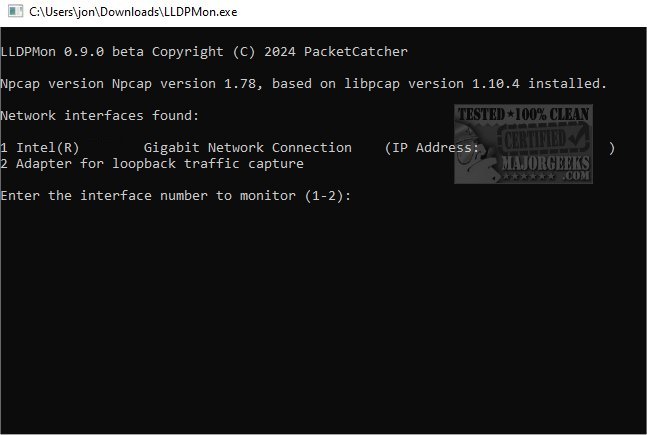LLDP-CDPMon is a network monitoring tool designed to capture and analyze LLDP (Link Layer Discovery Protocol) and CDP (Cisco Discovery Protocol) packets transmitted over Ethernet connections. These packets play a crucial role in exchanging critical information about network devices, including their identities, capabilities, and connectivity status. By utilizing LLDP-CDPMon, users can visualize a detailed map of their network topology, which aids in identifying potential issues or misconfigurations, especially in large and complex network environments.
For LLDP-CDPMon to function effectively, it is essential that the networking devices involved support LLDP or CDP and that the corresponding features are enabled on all relevant ports. If these conditions are not met, LLDP-CDPMon will be unable to capture any packets or display information.
Getting Started with LLDP-CDPMon:
1. Install Npcap: Ensure you have the latest version of Npcap, which can be downloaded from [Npcap's official website](https://npcap.com).
2. Run LLDP-CDPMon: Launch the tool and select the network interface you wish to monitor. To cease monitoring, simply press CTRL + C.
3. Command Syntax:
- Basic Information: Running `LLDP-CDPMon.exe` without parameters will provide basic information such as system name, system description, management addresses, port descriptions, and port ID/interface names.
- Detailed Information: By using `LLDP-CDPMon.exe /detail`, users can access all advertised information from the LLDP or CDP packets.
- Packet Capture: The command `LLDP-CDPMon.exe /capture` saves the captured LLDP or CDP packets to a file. For any unknown TLV (Type-Length-Value) messages encountered, users are encouraged to email the .pcap file to PacketCatcher@outlook.com for further analysis and potential inclusion in future releases.
Future Enhancements:
Looking ahead, there are opportunities to extend LLDP-CDPMon's functionality. Possible enhancements could include:
- Enhanced Visualization: Introducing graphical interfaces that provide real-time network topology maps, allowing for easier interpretation of the network landscape.
- Automated Alerts: Implementing a feature to automatically notify users of configuration changes or anomalies detected in the network topology.
- Support for Additional Protocols: Expanding the tool's capabilities to capture and analyze additional network discovery protocols beyond LLDP and CDP, increasing its utility in diverse networking environments.
- Integration with Network Management Systems: Creating APIs or integrations that allow LLDP-CDPMon to communicate with existing network management systems for consolidated monitoring and reporting.
By focusing on these enhancements, LLDP-CDPMon can further solidify its position as an essential tool for network administrators aiming to maintain optimal network performance and reliability
For LLDP-CDPMon to function effectively, it is essential that the networking devices involved support LLDP or CDP and that the corresponding features are enabled on all relevant ports. If these conditions are not met, LLDP-CDPMon will be unable to capture any packets or display information.
Getting Started with LLDP-CDPMon:
1. Install Npcap: Ensure you have the latest version of Npcap, which can be downloaded from [Npcap's official website](https://npcap.com).
2. Run LLDP-CDPMon: Launch the tool and select the network interface you wish to monitor. To cease monitoring, simply press CTRL + C.
3. Command Syntax:
- Basic Information: Running `LLDP-CDPMon.exe` without parameters will provide basic information such as system name, system description, management addresses, port descriptions, and port ID/interface names.
- Detailed Information: By using `LLDP-CDPMon.exe /detail`, users can access all advertised information from the LLDP or CDP packets.
- Packet Capture: The command `LLDP-CDPMon.exe /capture` saves the captured LLDP or CDP packets to a file. For any unknown TLV (Type-Length-Value) messages encountered, users are encouraged to email the .pcap file to PacketCatcher@outlook.com for further analysis and potential inclusion in future releases.
Future Enhancements:
Looking ahead, there are opportunities to extend LLDP-CDPMon's functionality. Possible enhancements could include:
- Enhanced Visualization: Introducing graphical interfaces that provide real-time network topology maps, allowing for easier interpretation of the network landscape.
- Automated Alerts: Implementing a feature to automatically notify users of configuration changes or anomalies detected in the network topology.
- Support for Additional Protocols: Expanding the tool's capabilities to capture and analyze additional network discovery protocols beyond LLDP and CDP, increasing its utility in diverse networking environments.
- Integration with Network Management Systems: Creating APIs or integrations that allow LLDP-CDPMon to communicate with existing network management systems for consolidated monitoring and reporting.
By focusing on these enhancements, LLDP-CDPMon can further solidify its position as an essential tool for network administrators aiming to maintain optimal network performance and reliability
LLDP-CDPMon 1.4.0 released
LLDP-CDPMon allows you to capture and analyze LLDP/CDP packets that are transmitted over Ethernet connections.


